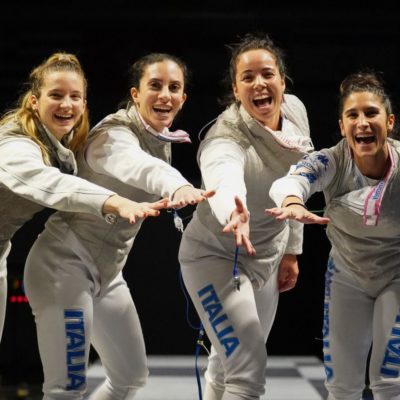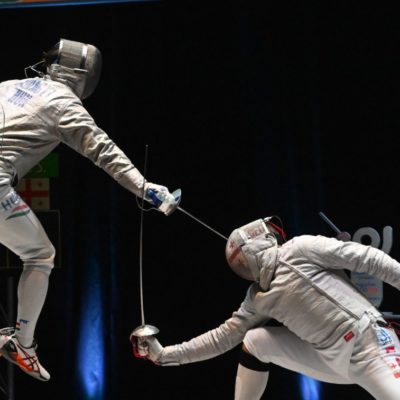Walter Flaschka reviewed the proposed foil timings and previewed his thoughts on what would happen to foil once they were implemented. We’ve now witnessed a few junior level events and finally our first Division I NAC event and can put the observations together. Are these timings good, bad, or just ugly for foil?
In his article, Future foil — foil after the FIE changes [link], Walter Flaschka made the following predictions about foil:
- More tip and point actions.
- Less flicks to the back, but flicks to chest and shoulder should still work.
- Increase in infighting due to compressed distance.
- Large invites and blade preparations will become more dangerous as there is no quick flick to the back to bail oneself out.
As with all changes to a system, the changes in the debounce timing for foil accomplished some of what was intended, but not by 100%, and also had some unintended consequences which should have been forseen or discovered during the concept testing phase before the FIE push forward with implementation.
Flicks are still alive
The flick is still alive and well. The flick to the back is much harder to pull off, but flicks to the forward shoulder and to the chest still land in both Division II (C and below) as well as Division I competitions. The fencer with good hand technique who manages their distance will still be able to score with the flick.
The decrease in effectiveness of flicks to the back have increased the distance that fencers need to be in for a good attack. They have also pushed the flick from primarily an attack move to a riposte move. At the Richmond NAC, most of the successful observed flicks were those taken as ripostes to the back/top of the shoulder and the flank.
The law of unintended consequences
This is the most disturbing result and hence the title of the article. The reduction in debounce timing was designed to make the flick more risky and to increase reliance on point actions. However, reports from the Atlanta Division II/III NAC, junior world cups, and the Richmond Division I NAC all indicate that some straight attacks do not score.
There are several reasons why this can occur – issues with the foil, issues caused by protective gear, and issues caused by the timings.
How can a straight attack "miss"?
Instances of a straight attack to the chest not triggering the scoring machine seem to be due to the increased velocity of attacks combined with the new debounce timings. When the attack hits, the tip is depressed. Then, as the blade bends one of two things can occur to nullify the point; the blade can bend too fast, causing the tip to be taken off of the target withing 15ms as the blade bends, or a portion of the blade or barrel that is not fully taped can come in contact with the lame within 15ms.
The equipment fix is easy – make sure that your foils are fully taped. This will require additional maintenence between bouts, but those "missed points" can be avoided.
Body armor anyone?
Another trend in foil is not the hard chest protector. These are the male version of the one-piece plastic protectors that are popular with female fencers. In some instances the hard check protector causes the foil point to bounce off the target faster, resulting in no light. This is exacerbated by fast compression of the distance (say, a counterattack) which causes the blade to bend faster and get the point off of the target.
Some fencers have "tweaked" their setup to wear the plastic chest guard between the lame and jacket. This setup apparently worked so well that the practice was banned in between rounds at a Junior World Cup early in the season.
Suicide is painless?
Another disturbing result is that the fast counterattack into a straight lunge can result in a one-light action for the counterattacker. This is because the attacker has set their distance expecting a rational response and is not expecting their opponent to jump on their blade. When the blade bends faster then normal, it causes the tip to debounce sooner – the result? Attack: No, Counterattack: Yes.
Combine the counterattack with a hard chest plate, and you’ve got an even bigger problem. Sure, it may only be one or two touches in a bout – but do you want your 14-14 match decided by a quirk in timing that rewards a suicidal action?
Practical Advice – What you can do
Given that these timings, while imperfect, are the world in which we are fencing, what can you do to maximize your ability to score? Here are a few tips that we’ve gathered from fencers and referees.
Maintain your equipment.
Armorers recommend that you inspect your tip-tape in between each bout. Make sure that there is no exposed metal on the barrel or top of the blade or you may see that beautiful disengage four end up as a one-light counterattack for your opponent! Pay attention to the grub screws, especially if they protrude as the German design does.
Expand your distance.
Fence at a longer distance. You don’t need to compress to hit a flick to the back. You’re going for light thrusts to the chest and flank now. This means that the right distance for you will seem too long. If you feel like you’re just outside of the right distance, then you’re probably at the correct distance for you.
Practice fencing at the expanded distance and get used to it. It should open up the game for some more feints, but you’ll need to be ready to accelerate the attack quickly to close the distance before your opponent can retreat and cause you to chase them recklessly.
Watch Golubitsky’s attack in preparation
Attacks into preparation are making a come back. Without the back flick to bail them out, attackers are more vulnerable if they make bad preparations. A quick attack into preparation followed by a quick retreat to avoid the initial attack seems to be working quite well for the top tier of fencers. These AIPs reflect the fencing style that Golubitsky displays in his DVDs (The Once Upon a Time DVD showcases several of these actions.)
The foil timings will most likely undergo another revision as some of the consequences were not fully thought out at the time they were implemented. The timing change was intended to be only for the junior world cups this season, but expanded to senior events once the logistical problems of maintaining two sets of scoring machines became apparrent.
While these will change, expect the thrust of the timing changes to remain. Point actions to the forward target will be emphasized and the window for making preparations will get smaller.
Have any tips or recommendations of your own? Share them in the Fencing.Net Forum.





